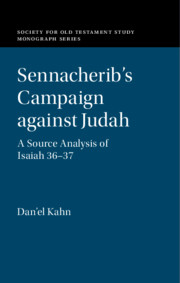Book contents
- Sennacherib’s Campaign against Judah
- Society for Old Testament Study Monograph Series
- Sennacherib’s Campaign against Judah
- Copyright page
- Dedication
- Contents
- Abbreviations
- Preface
- Acknowledgments
- Introduction
- 1 The Problems in Isaiah 36–37
- 2 Previous Solutions
- 3 A New Historical-Critical Solution
- 4 Source BI
- 5 The Political Events in the Eighth Century BCE and the Results of the 701 BCE Campaign
- 6 Source BII
- 7 The Historical Background of Source BII (683–671 BCE)
- 8 The BIII Strand
- 9 The Babylonian Period
- 10 The Question of the Priority of Isaiah 36–37 vs. 2 Kings 18:13–19:37
- 11 Isaiah 36–37 and Their Location in the Literary Unit Isaiah 36–39
- 12 The Present Location of Isaiah 36–39 in the Book of Isaiah and the Formation of the Book
- 13 2 Chronicles 32 and Its Relation to Isaiah 36–37
- 14 Summary and Conclusions
- Appendix – Biblical Texts
- Bibliography
- Index to Biblical Passages Cited
- Index of Geographic Names and Peoples
- Index of Names
2 - Previous Solutions
Published online by Cambridge University Press: 29 September 2020
- Sennacherib’s Campaign against Judah
- Society for Old Testament Study Monograph Series
- Sennacherib’s Campaign against Judah
- Copyright page
- Dedication
- Contents
- Abbreviations
- Preface
- Acknowledgments
- Introduction
- 1 The Problems in Isaiah 36–37
- 2 Previous Solutions
- 3 A New Historical-Critical Solution
- 4 Source BI
- 5 The Political Events in the Eighth Century BCE and the Results of the 701 BCE Campaign
- 6 Source BII
- 7 The Historical Background of Source BII (683–671 BCE)
- 8 The BIII Strand
- 9 The Babylonian Period
- 10 The Question of the Priority of Isaiah 36–37 vs. 2 Kings 18:13–19:37
- 11 Isaiah 36–37 and Their Location in the Literary Unit Isaiah 36–39
- 12 The Present Location of Isaiah 36–39 in the Book of Isaiah and the Formation of the Book
- 13 2 Chronicles 32 and Its Relation to Isaiah 36–37
- 14 Summary and Conclusions
- Appendix – Biblical Texts
- Bibliography
- Index to Biblical Passages Cited
- Index of Geographic Names and Peoples
- Index of Names
Summary
Already in 1886, Stade suggested that the Hezekiah-Isaiah narrative is a composite literary creation. He detected literary seams and suggested a combination of three sources. Source A: A chronistic record (2 Kgs 18:14–16, which is absent in Isaiah). Two further independent traditions about the deliverance from the Assyrian threat have been combined into one story: (a) Source B1: 2 Kgs 18:13, 17–19:9a and (b) Source B2: 2 Kgs 19:9b–37. Most scholars have accepted the identification of two consecutive accounts with an almost similar development of the narrative. Some scholars suggested different reconstructions of the putative sources and distinguish up to six strands spanning for hundreds of years.
Recently, proponents of the synchronic literary approach analysed the Hezekiah-Sennacherib narrative (Isa 36–37/2 Kgs 18:13–19:37) as a coherent literary composition; some include the putative source A, while others exclude it. They are mainly focused on the message, meaning, devices of writing, and form and structure of the narrative as it stands in its final form.
Keywords
- Type
- Chapter
- Information
- Sennacherib's Campaign against JudahA Source Analysis of Isaiah 36-37, pp. 23 - 67Publisher: Cambridge University PressPrint publication year: 2020

